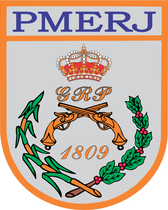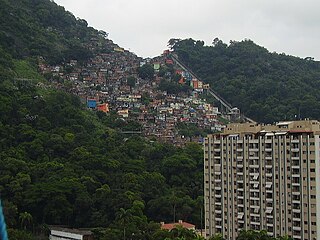
Favela is an umbrella name for several types of impoverished neighborhoods in Brazil. The term, which means slum or ghetto, was first used in the Slum of Providência in the center of Rio de Janeiro in the late 19th century, which was built by soldiers who had lived under the favela trees in Bahia and had nowhere to live following the Canudos War. Some of the last settlements were called bairros africanos. Over the years, many former enslaved Africans moved in. Even before the first favela came into being, poor citizens were pushed away from the city and forced to live in the far suburbs.

Rocinha is a favela in Brazil, located in Rio de Janeiro's South Zone between the districts of São Conrado and Gávea. Rocinha is built on a steep hillside overlooking Rio de Janeiro, and is located about one kilometre from a nearby beach. Most of the favela is on a very steep hill, with many trees surrounding it. Around 200,000 people live in Rocinha, making it the most populous in Rio de Janeiro.
Erismar Rodrigues Moreira, also known as "Bem-Te-Vi", was a gang leader in the Brazilian slum Rocinha, in Rio de Janeiro. He was considered to be the most wanted criminal in Rio during his prime.
Kátia Lund is a Brazilian film director and screenwriter. Her most notable work was as co-director of the film City of God.

In Brazil, the Federal Constitution establishes eight law enforcement institutions - seven titulars and one auxiliar. The titular institutions are: the Federal Police, the Federal Highway Police, the Federal Railroad Police, the Federal Penal Police, the State Military Police and Fire Brigade, the State Civil Police and the State Penal Police. Of these, the first four are affiliated to federal authorities and the latter three are subordinated to state governments. These public safety institutions are part of the Executive branch of either federal or state government. Apart from these eight institutions, there are others which affiliate to municipal authorities: the Municipal Guards. According to Minister Alexandre de Moraes of the Supreme Federal Court, "...the Municipal Guards are inserted in public safety as the auxiliary and related body of public security force..." Federal law 13,022 gave them de facto and de jure police attributions.
Comando Vermelho, also known as CV, is a Brazilian criminal organization engaged primarily in drug trafficking, arms trafficking, protection racketeering, kidnapping-for-ransom, hijacking of armored trucks, loansharking, irregular warfare, narco-terrorism, and turf wars against rival criminal organizations, such as Primeiro Comando da Capital and Terceiro Comando Puro. The gang formed in the early 1970s out of a prison alliance between common criminals and leftist guerrillas who were imprisoned together at Cândido Mendes, a maximum-security prison on the island of Ilha Grande. The prisoners formed the alliance to protect themselves from prison violence and guard-inflicted brutality; as the group coalesced, the common criminals were infused with leftist social justice ideals by the guerrillas. In 1979, prison officials labeled the alliance "Comando Vermelho", a name which the prisoners eventually co-opted as their own. In the 1980s, the gang expanded beyond Ilha Grande into other prisons and the favelas of Rio de Janeiro, and became involved in the rapidly growing cocaine industry. Meanwhile, Brazil's shift towards democracy and the eventual end of the military dictatorship in 1985 allowed the leftist guerrillas to re-enter society; thus, the CV largely abandoned its left-wing ideology.
Amigos dos Amigos is a criminal organization that operates in the Brazilian city of Rio de Janeiro. It was started up in 1998 when a member of Comando Vermelho was expelled from the organization for ordering the murder of another member. The gang's main rivals are Comando Vermelho and Terceiro Comando Puro. ADA controls many drug selling points in the North and West zones.
Proibidão, which literally translates to "strongly prohibited", is a subgenre of funk carioca music originating from the favelas of Rio de Janeiro where it began in the early 1990s as a parallel phenomenon to the growth of drug gangs in the many slums of the city. The drug gangs sponsored DJs and baile funks in the favelas they controlled to spread respect and love for their gang as well as hate to the other gangs. The music that resulted is proibidão.

Tim Lopes was a Brazilian investigative journalist and producer for the Brazilian television network Rede Globo. In 2002, the media reported him missing while working undercover on a story in one of Rio's favelas. It was later learned that Lopes had been accosted by drug traffickers who controlled the area, was kidnapped, driven to the top of a neighboring favela in the trunk of a car, tied to a tree and subjected to a mock trial, tortured by having his hands, arms, and legs severed with a sword while still alive, and then had his body necklaced—a practice that traffickers have dubbed micro-ondas.

Crime in Brazil involves an elevated incidence of violent and non-violent crimes. Brazil's homicide rate was 21.26 per 100,000 inhabitants in 2021, according to the United Nations Office on Drugs and Crime (UNODC). Brazil has one of the highest number of intentional homicides in the world with 57,358 in 2018. In recent years, the homicide rate in Brazil has begun to decline. The homicide rate was 20.89 per 100,000 in 2019 with 43,073 killings, down from 30.59 per 100,000 with 63,788 killings in 2017.

Vidigal is a neighborhood and a favela in Rio de Janeiro, Brazil.

The Military Police of Rio de Janeiro State (PMERJ) like other military polices in Brazil is a reserve and ancillary force of the Brazilian Army, and part of the System of Public Security and Brazilian Social Protection. Its members are called "state military" personnel.

Favela Santa Marta is a favela located in the Botafogo and Laranjeiras part of the Morro Dona Marta, that is also divided with the neighborhoods of Flamengo, Cosme Velho and Silvestre, in the South Zone of Rio de Janeiro, Brazil. It has about 3,913 residents and 1,287 domiciles, with 500 wooden houses, 2,000 brick houses, 4 kindergartens, 3 bakeries, 2 sports fields, 1 block of a samba school, 3 military units and 1 small market. The favela is one of the steepest in the city, with an altitude of 352 metres (1,155 ft), approximately 45 degrees of inclination and occupies an area equivalent to 53,706 square metres (578,090 sq ft).

In November 2010, there was a major security crisis in the Brazilian city of Rio de Janeiro and some of its neighboring cities. The city's criminal drug trafficking factions initiated a series of attacks in response to the government placing permanent police forces into Rio's slums.
Terceiro Comando was a Brazilian criminal organization engaged in drug trafficking in Rio de Janeiro. It was founded in the early 1980s and is a break-away faction of the Comando Vermelho.
Antônio Francisco Bonfim Lopes, better known as Nem or Nem da Rocinha, is a Brazilian drug lord and one of the leaders of "Amigos dos Amigos". Lopes had a net worth of R$100 million, was the undisputed head of all drug trafficking operations in Rocinha and branded by the Brazilian government as "Public Enemy #1".
Brazilian militias, mainly in Rio de Janeiro, and some other cities of Brazil, are illegal mafia-like paramilitary groups made up of current and former police officers as well as Military Firefighters Corps officers, criminals, politicians, and military officers, operating also as a regular mafia by trade extortion and political influence.

Marina Terra Maggessi de Souza, commonly known as Marina Maggessi, was a Brazilian police officer and politician, affiliated with the Popular Socialist Party (Cidadania).

The Vila Cruzeiro shootout took place on 24 May 2022 in the favela of the same name in Rio de Janeiro, during a joint operation by the Special Police Operations Battalion (BOPE), the Federal Police and the Federal Highway Police that resulted in at least 26 people killed by gunshots or cutting objects. It was the second most lethal police operation in the city of Rio de Janeiro, second only to the Chacina do Jacarezinho, which occurred a year earlier.

The armed conflict for control of the favelas in Greater Rio de Janeiro or simply Civil conflict for control of the favelas is an ongoing conflict between Brazilian militias, organized criminal groups Comando Vermelho, Amigos dos Amigos, Terceiro Comando Puro and the Brazilian state.











